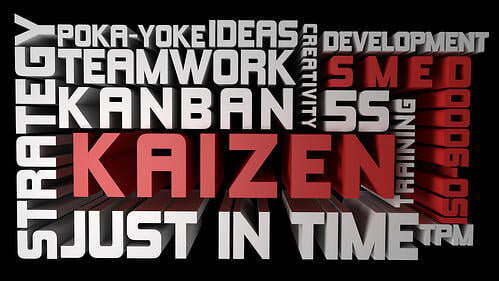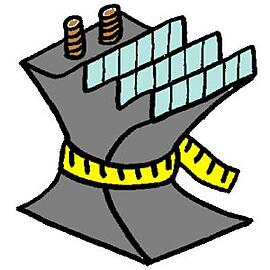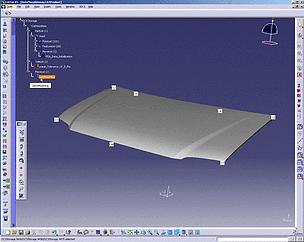
Happy Earth Day!
Every year, Earth Day comes as an important day to consider our impact on the world and our environment. There are a lot of ways to do this, from the fun 'test your carbon foot print' to the bold protests at environmentally unsound locations, sometimes far from civilization.
As part of the manufacturing world, we here at DCS believe strongly in Lean Manufacturing and Six Sigma concepts.
 Yeah, that much.
Yeah, that much.
The whole idea here is to do more with less. Create better quality products with less scrap and waste, while using more efficient systems to reduce costs. Put simply, make something better with less tooling and fewer or more efficient processes.
So how does this impact Earth Day?
Lean Manufacturing is usually done to reduce costs. Afterall, companies are not in business to make less money. However, that does not mean the manufacturing community is oblivious to environmental impacts.
As GM states on their website, "We’re committed to continuous improvement as we reduce the environmental impact of our vehicles and facilities. We’re making progress—through vehicles like the Chevrolet Volt, our 110 landfill-free facilities and by receiving an EPA ENERGY STAR® Partner of the Year - Sustained Excellence award. Not only is this the right thing to do, it’s proven to be great for our business."
Lean Manufacturing processes often bring environmental benefits along with them, and are usually a part of sustainability plans. 
Chrysler's CEO Sergio Marchionne is quoted on their site saying, "Sustainability is the foundation that must define our Company and guide our decisions and actions. It is the best path to guarantee merit and dignity to the results we achieve."
In following this path, Chrysler has created 99% reuse of water at its plants, saving 2.1 billion cubic meters of water in 2013 alone, as well as reduce the carbon dioxide emissions of their fleet by 25%.
GoAuto.com.au talks about Volkswagons Go Blue campaign to reduce environmental impacts. The site states, "Europe's biggest car-maker, Volkswagen, has committed to slicing the environmental impact of its factories by 25 per cent in six years because, it says, that will deliver a competitive advantage."
Now, given that was in 2011, the same year Greenpeace launched a campaign against the Volkswagon Group, who answered with the Think Blue, Factory campaign to reduce the impact of Volkswagon factories. This has dramatically reduced Volkswagon Plants' carbon footprint.
So what am I getting at here?
Lean Manufacturing is good for business, and good for the environment.
That's a win-win, no doubt about it.
So here's the kicker, how do you implement Lean Manufacturing?
 That's a harder questions to answer. You could hire a Lean Manufacturing consultant, get a Six Sigma Black Belt to create improvement initiatives, or you could get new tools to implement design and process changes to create leaner manufacturing processes and products.
That's a harder questions to answer. You could hire a Lean Manufacturing consultant, get a Six Sigma Black Belt to create improvement initiatives, or you could get new tools to implement design and process changes to create leaner manufacturing processes and products.
Of course, we would recommend all of the above.
But what if you can't do all of these? I mean, don't get me wrong, we all want to be leaner and save money. However, to save money, you often have to spend it, and we don't all have the budget to implement large Lean Manufacturing changes. Image coutesy Wisegeek.com
The Closed Loop Approach is one method of creating leaner processes.
Let me break it down and make it simple. As one method of implementing Lean Manufacturing, DCS solutions can make reducing Tooling, rework and scrap easy, while testing alternate processes and determinate assembly methods to improve efficiencies while reducing wastes.
Bottomline, DCS solutions can reduce your scrap by 40% while giving you the tools to improve your quality and test your design before building it. Design changes are easy before the plant has been tooled, but extremely expensive afterwards. This makes simulation and testing very valuable in the early stages of PLM.
3DCS Variation Analyst, or DCS's Variation Analysis Services, allow the user to simulate fixtures and tooling, granting the ability to simulate determinant assembly processes to reduce tooling and fixtures. With the ability to test assembly processes and build conditions at the same time, an engineer can see how assembly processes and tooling adjustments impact the complete assembly.
 Let's use an example. Airplanes are not made in one place, but built in sections in different geographic locations and then brought together for final assembly. At final assembly, nothing fits. Well, at least most components do not fit, at least not on the first try. Usually, not on the second either. This means that the assembly crews need to be good at reworking the fuselage and wings to fit in place, and use shims to make sure they are secure. Not only does this cost money, but it increases the weight of the plane, as well as using additional materials.
Let's use an example. Airplanes are not made in one place, but built in sections in different geographic locations and then brought together for final assembly. At final assembly, nothing fits. Well, at least most components do not fit, at least not on the first try. Usually, not on the second either. This means that the assembly crews need to be good at reworking the fuselage and wings to fit in place, and use shims to make sure they are secure. Not only does this cost money, but it increases the weight of the plane, as well as using additional materials.
For those you like me, I'll give the simple equation (thanks Wikipedia) -
![]()
Ok, so that's a bit much for a simple man like myself. I'd like to sum up the section we need for this article simply as:
Fuel Efficiency = 1/Weight
Where as weight increases, fuel efficiency decreases. I know, kind of a duh moment, but to put it bluntly:
If you can reduce the weight of a vehicle, whether aircraft or automobile, you can increase its fuel efficiency without any improvements to aerodynamics or engine fuel economy.
3DCS can be used to reduce the need for shimming and rework, as well as simplifying designs to reduce the amount of material needed for a product. Less material, less waste, less fuel consumption.
As an answer to this need to increase fuel economy in motor vehicles, companies are moving to lighter materials and composites. This can drastically affect the fuel economy of a car or truck, but has the side effect of being more difficult to work with.
Here's an example.
Ford's new F-150 pickup truck uses aluminum to reduce the weight of the vehicle. Ignoring the issues with body shops and aluminum body panels, the new truck has undergone a series of issues in production. Simply, aluminum does not react like steel does. When you apply pressure to it, it bends and deflects differently. I'm not a dimensional engineer, but if you google "Ford aluminum truck issues", you'll see what I mean. This isn't a criticism on Ford's design, I am personally very glad to see a vehicle utilize newer materials. It is just the issues of first to market products. As a trendsetting product, the new truck is moving into an environment not yet ready to handle the needs of the new material, and is being built in factories and by teams still getting used to working with the material.
So what am I getting at? 
3DCS and 3d simulation tools can be used with Finite Element Analysis software to account for material properties. This means that a user can simulate his/her processes on their product and see how the force, assembly and tooling will affect the aluminum or other material components of their assembly before building any prototypes or actual products.
This can alleviate a lot of potential headaches, and can very valuable down the line.
Long story short:
This Earth Day, think about how you can help the environment with Lean Manufacturing, which will help the bottom line at the same time.
DCS solutions are one method of implementing Lean Manufacturing, and dealing with special (low weight) materials.
Interested in more? Contact us and we'd be happy to show how DCS can help you reduce your cost of quality.
These Stories on CATIA
No Comments Yet
Let us know what you think